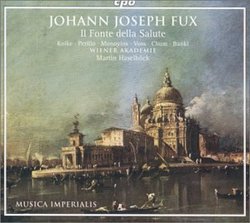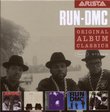| All Artists: Johann Joseph Fux, Martin Haselbock, Wiener Akademie Orchester, Ann Monoyios, Linda Perillo, Johannes Chum, Kumiko Koike, Ursula Fielder, Henning Voss, Wolfgang Bankl Title: Fux: Il Fonte della Salute (Oratorio, Op 23) /Koike * Perillo * Fiedler * Voss * Chum * Bankl * Wiener Akademie * Haselbock Members Wishing: 0 Total Copies: 0 Label: Cpo Records Release Date: 9/26/2000 Genre: Classical Styles: Opera & Classical Vocal, Historical Periods, Baroque (c.1600-1750) Number of Discs: 2 SwapaCD Credits: 2 UPC: 761203968022 |
Search - Johann Joseph Fux, Martin Haselbock, Wiener Akademie Orchester :: Fux: Il Fonte della Salute (Oratorio, Op 23) /Koike * Perillo * Fiedler * Voss * Chum * Bankl * Wiener Akademie * Haselbock
 | Johann Joseph Fux, Martin Haselbock, Wiener Akademie Orchester Fux: Il Fonte della Salute (Oratorio, Op 23) /Koike * Perillo * Fiedler * Voss * Chum * Bankl * Wiener Akademie * Haselbock Genre: Classical
|
Larger Image |
CD DetailsSimilar CDs
|
CD ReviewsA voice teacher and early music fan George Peabody | Planet Earth | 11/04/2007 (5 out of 5 stars) "YUMMY! YUMMY! ANOTHER GREAT EARLY MUSIC LISTEN. Johann Joseph Fux (1660-1741) represents the culmination of Austrian Baroque Music. The genre of his compositions included operas, oratorios, masses, requiems, motets, sonatas and keyboard music. He formulated the rules for counterpoint in his book 'Gradus ad Parnassum, which was the book that Haydn and Mozart used, for it typified the 'zenith of contrapuntal writing'. His oratorio 'Il Fonte della Salute aperto dalla Grazia nel Calvario' (The Fount of Salvation, Opened through Grace on Mount Calvary) is divided into two parts. The source of salvation, Jesus Christ, does not appear in person in Fux's oratorio, but is represented by three allegories 'La Grazia' (Grace-soprano Kumiko Koike), 'La Miseriacordia' (Mercy-soprano Linda Perillo), and 'La Giustizia' (Justice-soprano Ursula Fiedler). Grace is the principal allegory because she opens the fount. The Allegories see it as their task to lead the two Peccatori (Sinners: Countertenor Henning Voss and Tenor Johannes Chum)crucified at the right and the left of Jesus, to Salvation; and there, is also a Demon (Demonio- bass Wolfgang Bankl) who attempts to draw them into evil. And so it goes. This music is absolutely charming, not highly dramatic but containing some wonderfully tuneful melodies. It might be classified as :'Early Music Easy Listening'. The Weiner Akademie, under the capable direction of Martin Haselbock, does an excellent job of accompanying and soloing the various arias and recitatives There are only two choral selections that are sung by the six soloists, so there is no large ensemble singing. I didn't miss it because the solo voices are so skilled with a perfectly lovely sound, and there are many arias where they soloed accompanied by only one instrument. The three sopranos sound much alike: good clear high notes with each one having their own individual voice quality. Henning Voss, countertenor, sings with a smooth even sound throughout his range and his voice is VERY PLEASANT TO HEAR. The tenor was not as dramatic as I am accustomed to hearing, but his voice was flexible with good diction. The Bass was quite disappointing in his role as the DEMON. He was very 'laid back'; almost like he didn't want to be a bad bad person. Fux wrote some great arias for Demonio, but Bankl did not come through. This is my first Fux listening experience, and I loved it! I'm personally delighted with all these recordings coming forth with Early Music." A Ghostly Musical Reincarnation Giordano Bruno | Wherever I am, I am. | 02/05/2009 (5 out of 5 stars) ""Il Fonte della Salute" is something interestingly different from the norm of 18th C oratorios. Structurally, it's a conservative resuscitation of the 17th C 'oratorio at the altar' - remember that the word Oratorio derives from the Latin 'orare', meaning pray - developed by the Roman composers of the Counter Reformation as a response to the popularity of secular opera. But in another sense, Il Fonte is a surprising reincarnation of the Medieval liturgical drama, a musical dinosaur if you will, a ceremonial passion play with music of the High Baroque. Johann Joseph Fux wrote at least six such "sepulcher" dramas, all with different scripts, of which Il Fonte was the first, composed in 1716. The 'sepulcher' refers to a scene constructed in front of an altar in a church, in this case the imperial court chapel, where the 'acts' of the Passion and resurrection were played out dramatically and musically. Such Holy Week passion plays were effectively the only times when women could sing such operatic roles in a sacred setting. The whole tradition was not destined to survive the increasing influence of Protestant austerity, even in Vienna; Fux, a great innovator in symphonic orchestration, was also the last significant composer of 'sepulcher' dramas.
The characters in this drama are not Biblical but rather allegorical figures: Grace, Pity, Justice, A Demon, and two Sinners, one Contrite and one Obstinate. Theology aside, the literary merits of the libretto are not such that would justify singing this composition, were it not for the splendid music. It's in Italian, by the way, the language of courtly preference in Vienna until after Fux's lifetime. Conductor Martin Haselböck and his Wiener Akademie are stringently committed to historically informed performance. In the case of Fux, a huge amount of historical information is in fact available from the Austrian court archives, including exact instrumentation and sometimes even the identities of the singers. The orchestra for Il Fonte is: 5 violins, 2 violas, 1 cello, 1 viola da gamba, 1 violone, 2 bassoons, 1 chalumeau, 1 trombone, and an organ. The bassoons are prominent, and very well played, and the chalumeau, an unreliable beast of a transitional instrument, is quite handsomely tootled by Peter Rabl. The singers are sopranos Kumiko Koike (Grace), Linda Perillo (Pity), Ursula Fiedler (Justice); male alto Henning Voss (Contrite Sinner), tenor Johannes Chum (Obstinate Sinner), and bass Wolfgang Bankl (Demon). Since 'we' are listening for musical values more than dramatic ones, I have only praise for all of them except Linda Perillo, who doesn't quite satisfy my snobbery about perfect tuning. But she is by no means weak enough to diminish my appreciation of this whole 2-CD performance. There are no other available recordings of Fux's oratorios, except one being offered at scalper's prices, also performed by Haselböck and Co. In fact, to my standards, there are only four worthy performances on CD of the vocal music of Fux, one of the major voices of the Baroque. Two are by Haselböck and two are conducted by Rene Clemencic. This is the third of them that I've reviewed in recent days." |

 Track Listings (18) - Disc #1
Track Listings (18) - Disc #1
